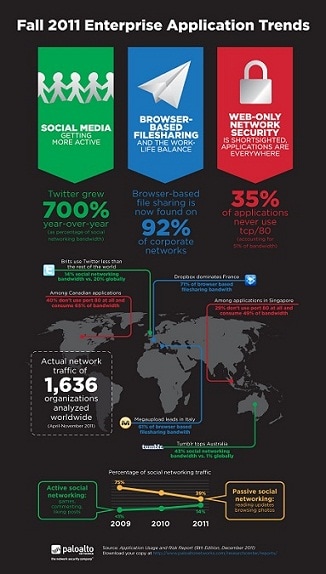In last week’s blog entry, Rene’ aptly termed 2011 as the Year of Me; the year when social media and a wide range of other personal applications were used in abundance on corporate networks. We predict that the usage patterns will continue and we need look no further than the latest edition of our Application Usage and Risk Report (December 2011) which highlights a significant shift from the passive or voyeuristic use we saw in October 2010to the more active, action oriented use that we see in this report. Social-plugins, Facebook apps, games and posting for LinkedIn, Twitter and Facebook viewed collectively, increased more than 300% in a year-over-year comparison while Twitter use increased a staggering 700%.
- Get the report: Application Usage and Risk Report, December 2011
- Slide show of key findings: Application Usage and Risk Report, December 2011
- Check out the 2011 year in review video: The Year of Me
In October 2010, social networking was (and in some cases, still is) the poster-child for bad applications. It was viewed as a huge productivity and bandwidth sinkhole; a position we proved to be false in October 2010 with the bulk of the bandwidth consumed to be browsing. At that time, examples of corporate use of social networking were hard to find. Fa st forward to December 2011 and examples from large, well known organizations such as Ford Motors, Caterpillar, and Nike are relatively easy to find. Is there some personal use mixed in with the corporate use? Absolutely. No one I know works 100% of the time while at work. In this case, organizations are figuring out the right balance between blocking and allowing these applications on the network. Something we call secure or safe application enablement.
st forward to December 2011 and examples from large, well known organizations such as Ford Motors, Caterpillar, and Nike are relatively easy to find. Is there some personal use mixed in with the corporate use? Absolutely. No one I know works 100% of the time while at work. In this case, organizations are figuring out the right balance between blocking and allowing these applications on the network. Something we call secure or safe application enablement.
The staggering 700% increase in Twitter usage can also be attributed to both corporate and personal use. Corporations have figure out that Twitter is a great way to keep in touch with their users, customers, and fans. We need look no further than our own Palo Alto Networks followers whom we can communicate with regularly.
Another reason is that Twitter has become a powerful tool that enables organizations, grass-roots or otherwise, to deliver their message to the masses quickly, effectively and repeatedly. There were examples where Twitter and other social media applications significantly influenced the volume of news about, and visibility of, a particular world-news event. Unrest in the Middle East, economic turmoil and associated demonstrations in Europe, disasters in Asia Pacific and the Occupy movement in the U.S. all experienced significant activity on social media applications.
Without question, social networking applications present organizations with ways in which they can reach new customers, build loyalty with existing customers and increase their business. But the pursuit of these rewards introduce business and security risks that must be considered and addressed.
Thanks for reading.